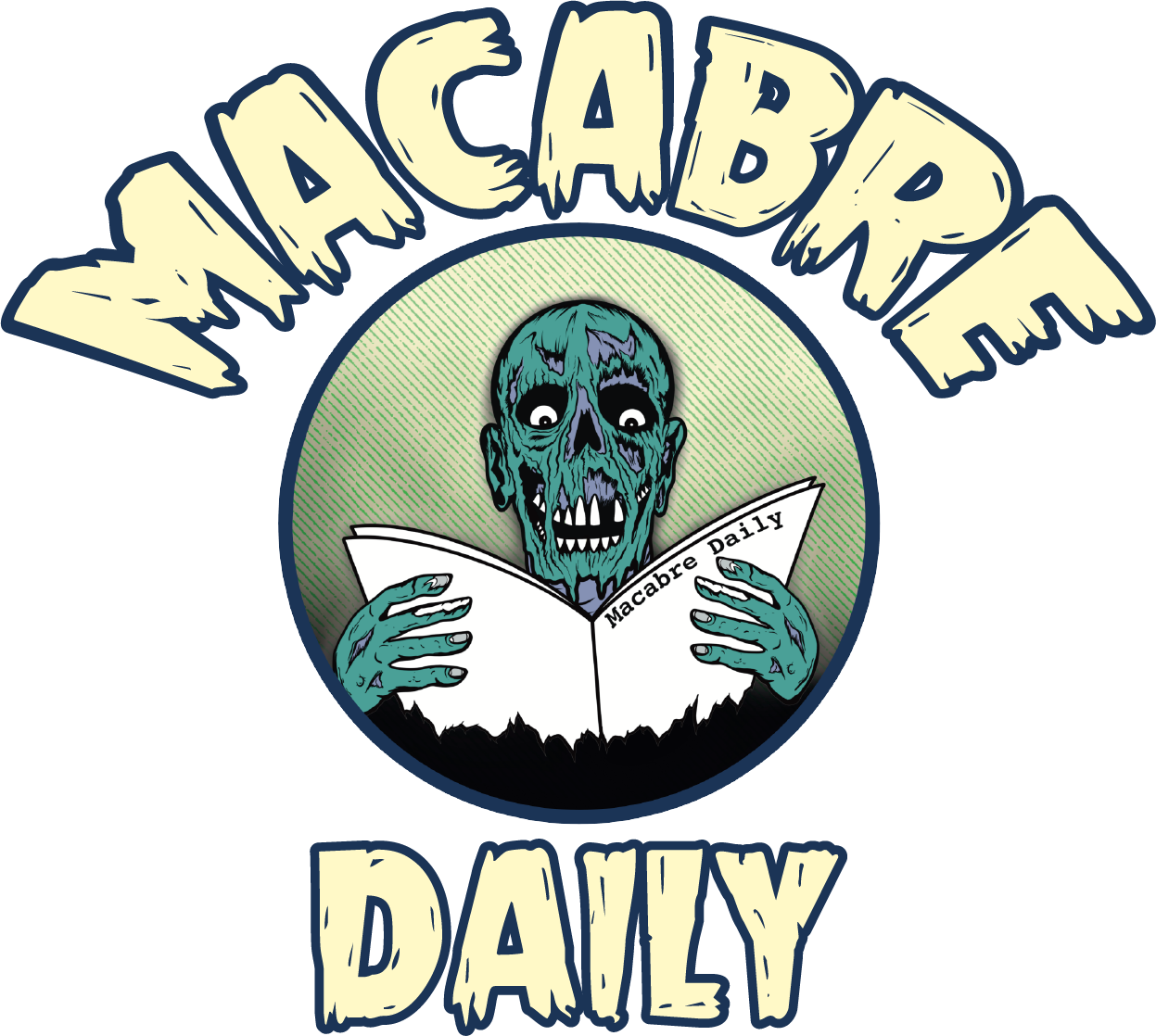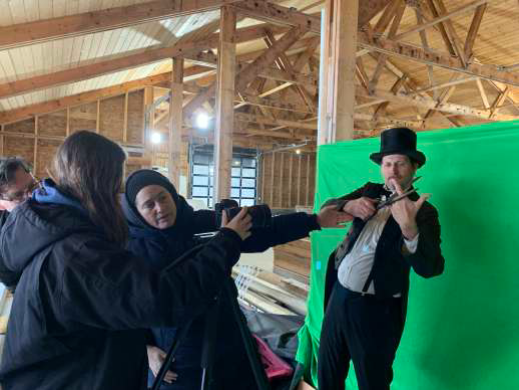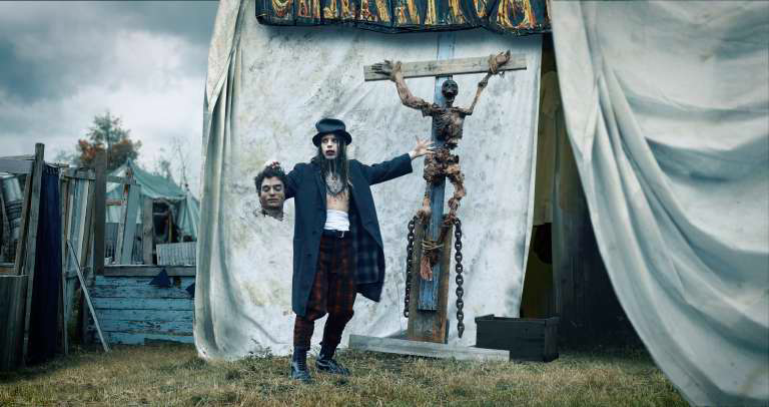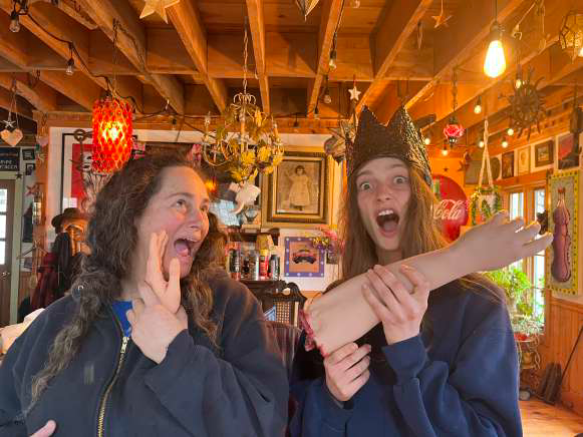The Adams Family Returns To Macabre Daily To Talk All About "Where the Devil Roams!"
Courtesy of Wonder Wheel Productions
It’s already November, but it’s safe to say this hasn’t been the most fruitful year for horror. Compared to the onslaught of great horror films last year, 2023 is struggling to keep up. Thankfully, the latest film from Adams Family is here to grace our top 10 lists alongside “When Evil Lurks” and “Thanksgiving” (oh, you know you loved it). Hot off the heels of last year’s “Hellbender,” “Where the Devil Roams” is about a family of murderous carnies who encounter a demonic force during The Great Depression.
We spoke with writers/directors/actors/almost everything else Toby Poser, her husband John Adams, and their special effects artist Trey Lindsay about the movie, getting permission to kill their daughters (and collaborators) Zelda and Lulu Adams on screen, and the problem with exploding heads.
Macabre Daily: What would you say is the bridge between your last film, the modern, self-contained “Hellbender” and the period horror of “Where the Devil Roams?”
John Adams: It originally came from Zelda. She asked if we had time to make one more movie before she left for college and we’re like “fuck yeah we do!” She had an idea based on a nightmare she had about a clown, but Toby and I pointed out it would be hard to dress like clowns for a year. Maybe if we dressed more like regular people from the 1930's it would be more doable. It evolved from there and we narrowed it down to us [playing carnies] and Toby came up with the [idea of] the magic heart.
Toby Poser: We have so much fun coming up with the mythologies of our films and Trey is a wonderful inspiration. He was kind of my personal horror mentor. He just knows everything and it's fun to run it all by him because he takes it to the next level with his intelligence.
Trey Lindsay: Oh, please [Laughs]. Honestly, one thing I never talked about with this film was about being privy to your brainstorming when you were figuring out what the movie was. Sometimes John came to me with effects-oriented ideas for mythology. The best ideas are simplified and the simpler it got, the more primal it felt. When you come up with the needle and thread with the heart, it sounds like it’s been around for 3,000 years and we’re borrowing it. Being the “adopted member” of the Adams Family, it’s great to see the brainstorming whittling away at bad ideas until we find the perfect one.
MD: What was pre-production like? Building a carnival in the 30’s couldn’t have been easy.
TP: We knew we were making this film when we were doing press for “Hellbender.” We were driving all over America, which was a great opportunity to stop at every vintage thrift store and junk stop we passed. By the time we got home, we assembled an arsenal of cool clothes and tchotkes that would work for the period.
JA: We looked at a lot of old pictures of county fairs and carnivals from the Depression and the 20’s that were in our area. They all looked dirty and simple and the people looked stunned and poor. It looked like we could build some of it with 2x4’s and canvas, but what about the tents and crowds? Any time we had visitors, we’d ask them if they wanted to be in the movie. Then we shot them on a green screen and Trey would put them in scenes. The carnival was dying, so we only needed about 5-20 people. Trey came in with the big tents, which I thought was the final, beautiful touch.
L-R: Trey, Zelda, Toby, and Sam Todd (Mr. Tipps) working with the green screen.
TL: That was so much fun, but hopefully people won’t notice a lot of those wide shots have painted elements in the frame. At the beginning, they’re blue-skying everything and going “what about a whimsical Tim Burton or Guillermo Del Toro carnival?” But the story isn’t about what happens at the carnival, but about the people behind the scenes, so they found the perfect kind. Like John said, canvas and 2x4’s go a long way to sell that you’re behind the scenes. When we needed a wide shot, we used digital matte paintings, which was the first chance I had to do that professionally. With every movie with John and Toby, we always tackle a different effect and it’s a chance to learn something new. With “Hellbender,” it was particle effects to represent magic, and here it was digital matte paintings to flesh out the world. We had shots where I painted out air conditioners and modern signs to make it feel authentic.
MD: As an effects artist, when they bring up Tim Burton, how do you address that with a small budget?
TL: The mattes cost the same whether you’re doing big Tim Burton stuff or not, so once we decided on the low-tech, behind-the-scenes look, it really informed what the paintings should be like. I joke with them that I’m always the one going ridiculously overboard in the beginning [Laughs]. I give them an 11 and we usually dial it back until we find the tone for that particular movie.
JA: Trey starts with a barrel of blood and we dial it down to about a cup of blood [Laughs].
MD: If “Where the Devil Roams” was a cup, what did the barrel look like?
JA: You’d love what the barrel looked like. Trey drew these big, beautiful tents for a very successful carnival. It looked great! But I had to tell him “these guys are so poor, we need to beat it up a lot.”
The cup of blood runneth over.
MD: The film itself looks dirty and feels cold in the best possible ways, reminiscent of “Wisconsin Death Trip.” What did you ultimately reference for the look?
TL: It’s funny you mention that because Zelda’s character takes photographs of the murders and I had this book called “Death Scenes,” which features homicide photographs from the 1940’s. Film noir from that period is romanticized, but when you look at the photos of the crime scenes, it’s brutal and depressing. I lent them the book as a sort of grim inspiration, but it was a perfect reference point for the film.
Toby and Zelda hunting for tchotchkes.
TP: Trey lends us the best things. Some people visit and bring flowers or baguettes. Trey’s like “here’s this book of horrors you can read for inspiration” [Laughs]. “Thank you, I will.”
MD: You’ve been making movies for a while, but only your last 3 films were horror, which was a surprise. How did you find your way to horror?
JA: We had a friend, Robert Huntley, who helped us with some technical stuff on some of our dramas. We made “The Hatred,” where we did all the effects and the blood. It was fun, but we realized we needed an expert to pull off the effects. When we went to make “The Deeper You Dig,” I asked Robert if he knew anyone who did effects, and he said he had a great friend, Trey Lindsay, and he lived near us. So we went out for pizza and had the best conversation. He’s a wonderful human, as you can see, and that’s who we want to work with. We were already shooting “The Deeper You Dig” when he asked if he could take a pass at our title [in the film]. He took it and gave it back to us a day later and it was exciting. It struck [Toby and I] that we had just taken a step up. He’s been a perfect partner ever since.
TL: Absolutely.
TP: I’ve always loved horror, but I never grew up reading Fangoria or Rue Morgue. When I stepped into horror with “The Deeper You Dig,” Trey introduced me to a lot of horror outlets and avenues. I’ve always taken his advice and now I subscribe to both [magazines]. If there’s something I want to know about or something I’ve seen and loved, I always go back to him and ask what he thought about it because he’s encyclopedic.
JA: It's also interesting because we had made 4 dramas, all of which go right up to the line of being horror, but they never crossed the line. What we realized after “The Hatred” was how much fun [horror] was to make, because you’re still making a drama but you can have more fun and be more creative. The artistic freedom of horror is so much bigger than the artistic freedom of drama. All of our horror is drama covered in blood.
TP: Our first film, “Rumblestrips” was meant to be a western ghost story. Zelda and Lulu were 6 and 11 at the time, but we just weren’t ready to “go there” and kill them. After a few dramas, we were. Maybe they were old enough to give their permission [Laughs].
TL: When you get the chance to make your own movie, you’re trying to recreate what you loved when you first fell in love with horror. I’m also speaking for myself because I’ve been a monster kid since I was 5. There’s a lot of creative repetition with first-time filmmakers, but the Adams family comes from a dramatic background, so they don’t have any of that baggage. They’re bringing their knowledge and expertise from doing family dramas, and grafting horror onto that. That’s one of the reasons their films stand out so much against other horror filmmakers who are just starting out. Take away the horror elements from their films and you still have a good drama.
JA: You see why we hang out with this guy!? [Laughs]
MD: Well that answers my next question: What did you learn from shooting your first period horror film, “The Hatred?” Hire Trey Lindsay. Got it.
JA: We also learned how great snow looks on film, so we shot “The Deeper You Dig” in the snow, too.
MD: You previously called Zelda and Lulu your “bullshit detectors,” but how are they detecting bullshit when the film takes place before all of you were born?
JA: It’s more about our delivery and honesty of character. If our acting is too much, they won’t beat around the bush. Like if I’m trying to act too tough, they might say “that looks cheesy” or “you’re trying too hard to be Clint Eastwood. Be more like John.” They’re excellent at that. This time, Toby was actually the bullshit detector when it came to things like costumes.
Zelda directing John.
TP: That’s true, but we gave ourselves leniency because we knew we didn’t have a million dollars or a costume shop. When we traveled for “Hellbender,” we collected what we could and worked with it. Just like with the music, we decided not to get hung up on being 100% accurate. We have music that’s not from that era, and actors who have tattoos and piercings they wouldn’t have had, but we embraced it to suggest there’s a universality to the carny.
MD: Without giving anything away, the film has an unusual structure. For most of it, you’re following the family in their everyday lives, but we don’t really get into their story until the third act. I’ll call it the “Lulu Moment.” Did that part of the story ever come earlier in the film?
JA: It was important to us to show the dynamic of the family beforehand. We’ve had people say we weren’t following a classic narrative, which is true, but we also don’t give a flying fuck [Laughs]. Once the “Lulu Moment” happens, the film becomes quite sad and still and we don’t see it as a sad movie [overall]. We want to build the family up because we see the film as very loving, and we didn’t want to spend too long trudging in the sadness. We talked about it a lot and at one point, it came earlier, but we wanted it to be like a fall into a well.
MD: It’s very bittersweet when you realize it’s a metaphor about sending your kids to college.
JA: Absolutely.
MD: Early on, Seven has a WWI flashback and there’s a moment where a soldier is killed by a headshot. I’ve never seen someone get shot in the head, but it looked very real. Can you talk about what went into making it?
JA: We worked really hard on that and you’re the first person who noticed it. So thank you! Two things. First, the whole point [of the flashback] was to show Seven’s character development. We knew we wanted him to do something gruesome by trying to save this soldier’s gangrenous arm, but then fate would still ruin his day. We had an arm made with a tube in it and Trey made the blood come through the tube while I cut the arm. I think it was pretty effective. We’d wanted to combine the dirtiness of “The Golden Glove” and the unflinching element of “The Sadness,” which never cut away. The headshot was actually a real shotgun blast to a prosthetic head, which actually vaporized it. Trey added some meat and extras, right Trey?
Zelda films John and Trey as they prep for the infamous headshot.
TL: Yeah, it was kind of the old Tom Savini trick where you blow away the fake silicone head. We had some beautiful silicone prosthetics that we used throughout the movie, and this one was filled with chicken meat and whatever we could stuff in there. But it happened so fast, it was hard to tell if it worked. You have the fake head, but one frame later there’s just mist. We filmed the actor in the same spot, but the real effect was blending 5 frames of him with the silicone head exploding. The fleshy whip as the head explodes makes it more disturbing. It’s painfully simple how you approach it, but the artistry is making the transition between the actor and the fake head. If you go frame by frame, you can see a bloom of red I had to paint from the fake head, which is on top of the actor. It’s amazing how effective 5 frames could be [Laughs].
JA: It was a prosthetic head that was knocked off a dummy. We were lucky there was a tree right behind it because it blew the head right off, hit the tree, and bounced back. If it had just disappeared, you might not be able to tell what happened.
MD: After 2 consecutive films and your kids going to college, are you taking a break or do you have something else coming up?
TP: There’s never a break. We’re always “slinging spaghetti” as we and Trey like to say. Seeing what ideas are gonna stick. Fortunately Zelda wants to take time to work with us again, and we have something in the cooker.
JA: We have 2 movies we shot over the past year. We shot one of them in Serbia with Trey and we’re already building sets and working things out with Trey on our next project.
Interview edited for length and clarity. “Where the Devil Roams” is in theaters and On Demand now.
Stay up to date with “The Dark Side Of Pop Culture” by following MacabreDaily on Instagram, Facebook, and Twitter.

















